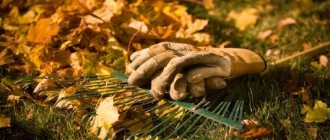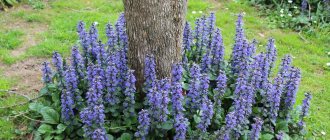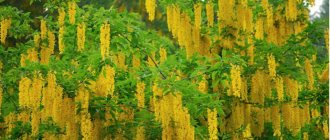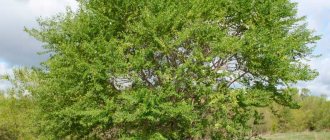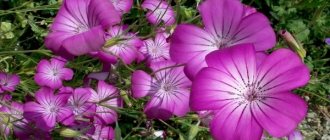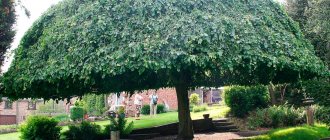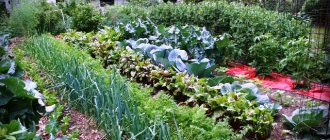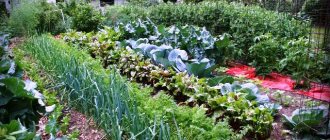3 219
Pine bark mulch is an excellent means of protecting beds from sudden changes in temperature. It is used everywhere, in beds, flower beds and front gardens. Below, we will try to find out in more detail how to use mulch in the garden, and what methods of using it in the garden exist.
Pine bark is the best mulch for the garden
Pine bark is a natural product given to us by nature. Today you can purchase or make several types of such material yourself, namely:
- small variety;
- middle fraction;
- large variety.
This type of mulch is an ideal covering for the soil. The fact is that pine bark crumbles and decomposes very slowly. As a result, such protective material is the most reliable and durable. The vast majority of bark is used to protect trees and various shrubs.
It is worth noting that such material is also an excellent fungicide of sorts, which prevents the appearance of parasitic insects. Thanks to this, every gardener can maintain his garden without the use of various chemical preparations.
But that's not all, the bark is an excellent natural shelter from freezing, as well as an ideal decorative design.
The main advantage of this material is that it is resistant to all external and negative factors. In other words, frost, snowfall and rain will not be able to destroy the bark, since it perfectly absorbs moisture and immediately gives it to the crops that it protects.
Large variety of pine bark mulch allows moisture to pass through perfectly, so watering can be done without removing it. It is worth noting that if before laying mulch watering was done daily and abundantly, then after covering with mulch you can moisten no more than once a week.
Common Mistakes
It is not recommended to use old material for backfilling. Particularly harmful is the one that was stored without compliance with the standards, in the open air, then the probability that it is contaminated approaches 100%. If wood chips remain on the site longer than expected, then they need to be removed; this is done after winter, when the unrotted material thaws.
Early scattering over the site harms young, immature trunks; they become weak and stretch too much. The optimal period is considered to be the time when the shoots rise by at least 10 cm.
A layer laid without loosening can cause damage. The loose outer layer creates aeration; if a dry crust has formed, then the access of oxygen is limited, and the cover laid on top aggravates the situation. If you don’t loosen it, the plant develops worse.
On light substrates the layer is larger, from 60 mm, on heavy thinner ones - no more than 40. If you pour less than necessary, then protection against drying out and weed varieties becomes ineffective. Excessive thickness creates good conditions for the accumulation of moisture and rotting begins at the border with the soil, which gradually covers the plants.
Organic matter must be constantly monitored and replaced at the first sign of deterioration. It is not necessary to sweep away all the material; you can limit yourself to areas that have lost their original properties.
Pros and cons of bark mulch
Often pine bark is used in the front garden as a decorative covering around rose bushes or trees. In this case, in addition to giving a well-groomed appearance to the front garden, it performs two more important functions, namely:
- protects trees from severe frosts in winter, warming their soil;
- and in warm seasons it makes the earth cooler and retains moisture in it, preventing it from evaporating.
Today, the bark of coniferous trees is simply an ideal option as mulch. This component has the following advantages, namely:
- environmentally friendly material;
- looks great in various flower beds, due to which it is a favorite material of many landscape designers;
- does not fly apart during strong gusts of wind;
- does not contain various dyes;
- after decomposition occurs, no harmful elements enter the soil;
- the bark is durable in use, about 6 years;
- It has a high amount of antiseptic component in its composition, due to which various parasites do not multiply.
It is worth adding separately that such material has many advantages in use, namely:
- blocks weed growth;
- perfectly retains moisture in the soil and protects from drying out;
- there is no need to regularly apply mulch;
- does not allow a crust to form on the soil surface;
- protects against the appearance of various parasites, including moles;
- prevents the attack of various defects.
Pine bark mulch fits perfectly into any landscape. Moreover, unlike inorganic fertilizer, it decomposes and does not leave harmful waste. But it is worth emphasizing that it will not completely protect against the growth of weeds, it can slow down their growth and significantly facilitate the care of planted crops.
Stick to minimalism
There is no need to oversaturate your site with a wide variety of plants. This makes gardening more difficult.
When organizing your garden, you should adhere to minimalism. It is enough to equip an alpine hill, plant perennials and several beautiful trees.
Many gardeners dream of a good harvest. In this case, you need to minimize the number of ornamental plants and focus on garden crops.
How to make bark mulch yourself
Today, purchasing ready-made mulch is not difficult, but its cost can sometimes be confusing. Therefore, if a person has a desire to save hard-earned money, then it is worth visiting the forest and choosing a tree from which we will obtain the necessary material, but do not forget a few rules, namely:
- bark is not removed from young trees;
- old trees with defects or fallen trees should also be avoided;
- Having chosen a suitable tree, you need to check how the bark separates; if it comes off easily and does not break into pieces, then the tree has been chosen correctly.
You can prepare material for mulch from trees that were cut down no more than six months ago. The resulting bark is cut using special scissors or pruners. As for the size of the fraction, in this case it is crushed according to the direction in which it will be used.
Succulents
If you forget about watering, then plant succulents in the garden: cacti, agave or echeveria. These plants are very popular in landscape design. They will decorate your landscape.
Involving minors in begging: why you can’t “give in”
Honey from a cave: record-breakingly expensive honey collected in Turkey
Kindness has been found to keep you healthier than exercise.
Succulents are hardy but need good drainage. They require loose soil and infrequent watering.
When is mulching performed?
The best period for mulching is spring or autumn. If such a procedure is planned for spring, then this manipulation should be started at the moment when the earth warms up. As a rule, this time occurs when the first weeds appear in the garden.
This procedure is performed as follows: before laying out a layer of mulch, the soil is thoroughly fertilized. Then, pour a 6 cm layer of this material. As soon as weeds begin to appear, they need to be pulled out in such a way as not to disturb the layer of mulch poured.
It is also worth noting that if you plan to mulch the beds in the garden, then this procedure is carried out only after the planted crops have sprouted.
If mulching is planned in the fall, then such manipulation is performed depending on the task at hand, namely:
- mulching in September is carried out in order to retain all useful substances in the ground;
- starting in November, mulch is covered in order to protect crops from severe frosts.
And also, closer to winter, they try to renew last year’s layer of such material to protect crops.
Plan your site
Highlight the main areas of your site. This is a parking lot, a recreation area and a vegetable garden.
It is better to place the place for the car closer to the gate. Set up a relaxation area in the most beautiful corner of the garden. It is convenient to place it next to some building where you can store dishes.
As for the vegetable garden, it is better to place it in a sunny and high place. This will allow the plants to receive more light and oxygen.
Where is mulch used?
First of all, it is worth emphasizing this detail: if you plan to use mulch for the first time, then it is better to do this in the spring. This material is used in any area, be it beds with planted vegetables or areas where homemade berries are planted.
All three types of varieties are used as mulch, but they are still used for their intended purpose, namely:
- large pieces of bark are best used as decoration;
- For berry beds, both small and medium fractions are suitable, this also applies to vegetable zones.
At the same time, when a gardener begins to cover it with such material, it is necessary to take into account that the bark completely decomposes in an average of 4 years. Therefore, as soon as the layer begins to shrink, it needs to be updated.
How to properly mulch the soil with pieces of pine
In order to properly perform mulching, you must first prepare the land. To do this, you need to wait until the snow is completely gone from the ground, it dries out a little and warms up. As soon as the soil is ready, it needs to be slightly loosened to a depth of 7 cm.
It is important to understand that it is not recommended to mulch wet soil, since such manipulation will be of no use. On the contrary, there is a high risk that the ground under the mulch will be affected by infections of fungal origin.
When starting mulching, you must adhere to the following rules, namely:
- first all weeds are removed;
- all fallen leaves from last year are removed;
- dry soil is pre-moistened;
- fertilize: for this you can use bird droppings, rotted humus or even compost;
- if there is a need, then they also add fertilizers of mineral origin.
When all the above steps have been completed, begin adding mulch in a layer of about 7 cm. It is worth emphasizing that the thickness of the layer directly depends on the density of the soil. For example, if the soil is clayey, then the bark covering is made no more than 3 cm. If the area under the mulch is loose or sandy, then the thickness of the okra is increased to 7 cm.
Decorative wood chips for children's playgrounds and sports fields
You can use decorative wood chips not only in the garden. Since decorative wood chips are an environmentally friendly, free-flowing and safe material, they are often used in playgrounds.
Children will love the colorful design of the playground. In addition, thanks to a special manufacturing and embossing method, wood chips are a safe material. Children will be able to run around the playground even barefoot, without fear of getting a splinter or cutting their feet. Since the wood chips prevent the appearance of dirt, parents can be calm about the appearance of their children.
Related article: Step-by-step insulation of loggia and balcony
Decorative wood chips create comfortable conditions for training on sports fields. It is safer to play sports on an area covered with wood chips than on an asphalt area.
The use of decorative wood chips in landscape design evokes extremely positive reviews. Many gardeners, having used such a coating on their site for the first time, use wood chips for many subsequent years. After all, with the help of decorative wood chips you can realize the most extravagant ideas for landscape decoration, thereby adding originality to your site.
Some tips from experienced gardeners
Today, thanks to the experience of experienced gardeners and gardeners, which they happily share, it is much easier for novice farmers to carry out various manipulations on their site. We invite you to familiarize yourself with some tips that will help you avoid mistakes when applying mulch for the first time.
So, what do experienced gardeners advise:
- When this material is laid, it is necessary to ensure that the mulch layer is not poured close to the trunk of the tree or shrub.
- It is not recommended to use coniferous mulch before May. The fact is that the bark prevents sunlight from reaching the ground, so the first young may appear very late.
- Before you start using mulch, the soil needs to be thoroughly moistened or this procedure must be done after a good rain has passed. It is important to understand that the fine and medium fractions do not allow water to reach the plants in full.
- If a sunny area is mulched, the bark layer should be much thicker, unlike the darkened areas.
And, of course, it is worth remembering one golden rule: fresh pine bark is not used as mulch. Since such material contains a large number of harmful elements that can affect the growth of young animals. And of course, you need to remember that even the driest material should be thoroughly dried in the sun.
Group the plants
Do not scatter plants randomly throughout the area. They need to be grouped into a single composition. It should be large enough.
Combine flowers of the same variety and several accent shrubs into one group. Create several of these “spots” in your flowerbed.
This rule also applies to trees. They can be planted in rows, alleys or arrays. Woody plants should create a bright accent in garden areas.
Laying
Treatment with aseptic/insecticidal preparations suppresses the vital activity of microorganisms necessary for rotting organic matter and turning it into humus, so the layer of agricultural mulch must be watered with special preparations:
- nitrogen-containing fertilizers, because microorganisms intensively consume nitrogen from the soil, worsening its characteristics;
- alkalizing substances (lime or ash solutions) that compensate for the increase in soil acidity;
- reagents containing the necessary microorganisms (Tamir, Baikal, Gorynych and others).
After processing the agrotechnical layer, you can lay the decorative one. However, it is undesirable to cover the area with decorative mulch without laying an agrotechnical layer, as this will greatly worsen the condition of the soil.
Common hazel Contorta (Corylus avellana 'Contorta')
Common hazel can hardly be called an ornamental garden shrub. But its twisted shape deserves special attention! The hazel tree is beautiful not so much for its pleasant brown bark as for its curved and tightly curled buds. From a distance, the bare shoots resemble nothing more than a tangle of writhing snakes.
In the middle zone, the height of the bush rarely exceeds 1.5-2 m, and in warm regions it can reach 4 m. Contorta hazel can also be grown in containers. It is best to plant in sunny areas.
Pruning of this hazel is minimal: in the spring, before the buds swell, it is enough to cut off damaged, old and ugly shoots.
Hazel is frost-resistant, winters well in the middle zone, and rarely gets sick.
This plant can be planted in groups as a hedge.
Bottom line
Of all the materials used for mulching, tree bark seems to be the most optimal option. It has a number of advantages:
- retains moisture;
- provides thermoregulation;
- protects against the dispersal of weeds;
- suppresses the growth of weed perennials;
- repels pests;
- during the decomposition process, it fertilizes the soil and improves its structure.
Bark mulch has an attractive appearance, and plantings with it look well-groomed and neat. If there is a forest near your site, you can easily prepare the raw materials yourself by removing the bark from cut trees or fresh dead wood.
The material must be dried, cut into pieces of the required fraction and a disinfection procedure must be carried out by cooking or calcining in the oven. After this, the bark can be used to mulch plantings, scattering it on beds, flower beds and around shrubs and trees in a layer of 5-7 cm.
Red dogwood (Cornus sanguinea)
Another variety of svidina is blood-red (an alternative name is red derain). This bush, like its “brother,” boasts a luxurious red hue of buds. True, in his case the color often becomes more reddish, almost orange.
In summer, the foliage of this tree is dark green, and in autumn it turns purple-orange. The inflorescences, like those of the previous deren species, are white. You can tell the two varieties apart by their fruit: they are blood red and bluish-black, almost like ink.
Acer palmatum
The palm-shaped maple is a luxurious ornamental tree native to Japan. It is valued not only for the beautiful shape of the leaves, characteristic of other maples, but also for the variety of colors of the bark.
For example, the Bloodgood maple has buds and foliage of a rich wine color, while the Sango Kaku variety has orange-red branches and light green leaves that turn yellow in the fall.
Spider maple Bloodgood
The height of a tree depends not only on the variety, but also on the conditions of formation and cultivation. On average, palm maples grow to 4-10 m in height.
This crop is surprisingly frost-resistant, rarely gets sick, and does not require frequent pruning.
Palm maple variety Sango Kaku
Training and preventive pruning are carried out no earlier than 2-3 years of life and always in the fall, at rest.
Fertilizers
Mulch can be used in 2 ways:
1) A layer of rotted manure is laid and covered with bark on top.
2) Mix pine bark with horse manure 2:1 and place a layer of 5-7 cm on the bed. Space is left around the trunks for air exchange.
Organic fertilizers are buried at the optimal distance for feeding the roots - this is 20 cm. If the fertilizer is placed at a shallow depth, the plant will not be able to fully absorb the nutritional compounds. Rotted horse and cow manure is excellent as fertilizer. For 1 m² of land, 4 kg of horse and 5-8 kg of cow manure are needed. Other organic fertilizers are also used. Compost and peat will supply the soil well with nutritious compounds. It can be mixed with mulch and buried in the ground. For 1 m² of plot, 5 kg of compost and 2.5 kg of peat are used.
Mineral fertilizers are applied as needed: nitrogen, phosphorus and potassium.
The thickness of the mulching layer depends on the density of the soil. If it is clay soil, then the thickness will be up to 2 cm. Sandy soil - up to 8 cm. The beds are mulched once every 2-3 years.
Fresh pine bark cannot be used. It contains substances that affect the growth of the crop. Before use, it is dried in the sun for 2 months. It’s even better to use raw materials that have been in the forest for more than 6 months.
